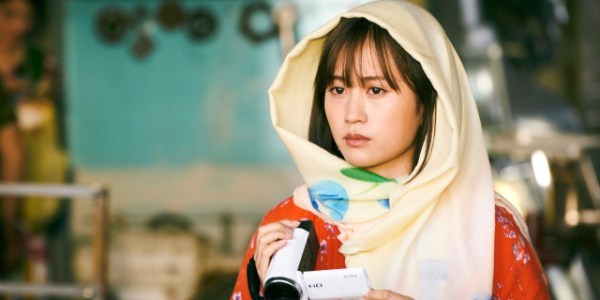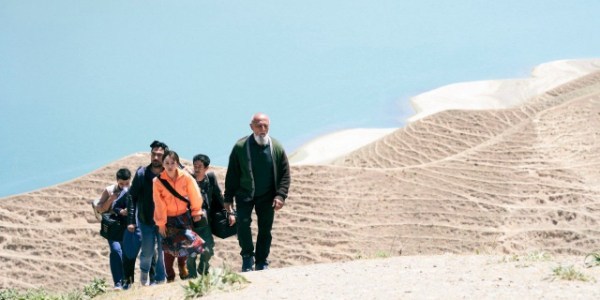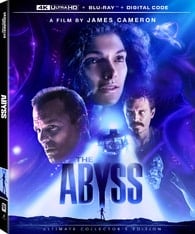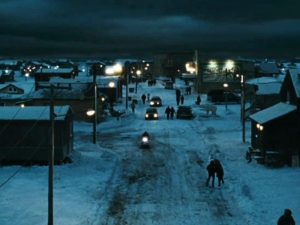If there’s a unifying dynamic to be found in Japanese director Kiyoshi Kurosawa‘s last two major films, it’s an intense focus on characters who are totally out of their element. In 2017’s Before We Vanish, the director presented a science fiction spin on the fish-out-of-water narrative, following a group of aliens masquerading as humans in contemporary Japan. To the Ends of the Earth, finally hitting stateside virtual cinemas after a lengthy pandemic delay, revisits the theme of the outsider, albeit in a decidedly more realistic fashion. Following a Japanese television crew in Uzbekistan, Kurosawa engages with a group of characters who similarly feel out of place in a foreign land, relying on the kindness of strangers and the limited Wi-Fi connection in their hotel.
Best known for unnerving horror films like Cure and Pulse (though his career is remarkably varied and diverse, ranging from period pieces to family dramas), Kurosawa‘s status as a director may lead some to believe that there’s a horrific twist in waiting. Indeed, much of the film portends such a development—as TV reporter Yoko (Atsuko Maeda) wanders the streets of Tashkent, the ever-present gaze of the citizens adds a powerful level of tension to the rather quiet proceedings. Ultimately, the film eschews any further disturbing turns, opting to preach a welcome message of tolerance and understanding in this culture clash. Yet regardless of its narrative, it’s Kurosawa‘s focus on Yoko — and Maeda‘s marvelous performance — that keep the movie afloat, allowing it to unfold, develop, and deepen at its own wonderful pace.
Japanese Television Crew Travels in Uzbekistan
When To the Ends of the Earth begins, Yoko, a reporter for a television show in Japan, is frantically joining her crew to film at a lake in Uzbekistan. Along with producer Iwao (Ryo Kase), assistants Yoshioka (Shōta Sometani) and Sasaki (Tokio Emoto), and local translator Temur (Adiz Rajabov), Yoko is hoping to chronicle the major sights and sounds of the country for her program. At the lake, they’re intending to capture a special fish, yet the fisherman says it’s a bad day for it — and he claims it’s because Yoko is a woman. Not a great start for their journey in Uzbekistan.

Unfortunately for Yoko and company, the incident at the lake comes to characterize most of their interactions in producing this series. When they attempt to sample some food, Yoko quickly learns that it’s undercooked. She later goes on a particularly exhausting amusement park ride, riding it again and again until they get the best shot — and until she vomits. As she wanders the streets of Samarkand and Tashkent looking for food, she is constantly gazed at by men and women, who seem to instinctively recognize that she’s an outsider. Frightened and encumbered by barriers of language and culture, Yoko is lonely in this new land.
Yoko is most at ease when she’s back in her hotel room, texting her boyfriend in Tokyo, who works as a firefighter for the city’s sea patrol (this seemingly innocuous plot point will become critical later). Though she never truly settles into her surroundings, Yoko opens up to her colleagues and develops her own interests in Uzbekistan, giving the spectator better insight into her psyche. She reveals that she still wants to be a singer, and she embraces their visit to a crucial performance space with connections to Japanese culture. Kurosawa never departs from the film’s basic tension: unusual as it may seem, this is a story that culminates with a chase scene through the Tashkent bazaar. Yet it also builds to a crucial line, one that sums up the film’s depiction of this culture clash: “If we don’t talk to each other, we can’t get to know each other.”
Unusual Mix of Genres and Tones
This message of tolerance is in line with the very ethos of the project, which originated as a celebration of the 25th anniversary of the diplomatic relationship between Japan and Uzbekistan. However, if this synopsis also seems strange, contradictory, and puzzling, that may actually be by design. To the Ends of the Earth keeps the viewer in a peculiar position for much of its running time, leaving them in suspense to wonder if — or when — the film will attach itself to a more conventional narrative of some kind. While that never exactly happens, Kurosawa‘s stellar touch keeps the film engaging by focusing almost exclusively on Yoko’s subjective experience. The film’s simple premise initially appears to merely depict the challenges inherent to the production of a cross-cultural TV program, but our link with Yoko infuses each of these sequences with a sensation of anxiety.

Indeed, while Kurosawa never indulges his own skillful brand of horror, To the Ends of the Earth is rife with uncanny and ever so slightly unnerving imagery. Presuming that few viewers speak both Japanese and Uzbek, there’s a significant language barrier that stretches from Yoko to the viewer — without the help of Temur’s translation skills, she’s in a subtle state of dread, unable to connect with the local citizens. Furthermore, she’s the constant subject of an intimidating gaze: when she changes clothes inside their production van, the locals stop, stand, and stare through the van’s window.
Though these conflicts may seem relatively innocuous, the tension reaches a boiling point whenever Yoko is on her own, especially in two key setpieces. In the first, Yoko leaves her hotel room after a grueling day, hoping to find some food in the city. But the simple trip becomes nightmarish: lost in the city, a visibly shaken Yoko moves through the dark streets at night, afraid that she won’t get back to the hotel room alive. Later, Yoko has gained more confidence as she moves through the Tashkent bazaar, filming everything in sight. Yet when she films in a restricted area, Yoko is confronted and chased by police who she can’t understand — the cherry on top of a tumultuous trip.
“If We Don’t Talk to Each Other, We Can’t Get to Know Each Other”
The frantic chase, in which Yoko avoids cops around Tashkent, eventually leads to her capture and the emergence of the film’s message of understanding and empathy. This message is appreciated and results in an emotionally cathartic interlude, which sees both Yoko’s acceptance of her own journey and the Uzbek authorities solving a crisis for the production crew. However, the function of this sequence as a dramatic reveal, calming both Yoko’s nerves and the viewer’s anxiety, opens up a more problematic reading.

Though there is no shortage of empathetic portrayals of the Uzbek citizens prior to the finale, the film’s limited perspective veers dangerously close to rendering them as “other,” as utterly foreign groups with different values that Yoko and company simply cannot understand. Despite this possibility, I don’t wish to condemn the film for this move: it is obviously part and parcel of the film’s dramatic approach. Moreover, Kurosawa gives numerous hints of this empathetic attitude in the early goings — when a local fisherman makes a sexist remark, Temur strains to tell Yoko that not everyone in Uzbekistan is like him. One could simultaneously argue that, by design, the film is meant to constantly reflect Yoko’s own nervousness; is everyone really staring at Yoko in the streets, or does she merely feel their watchful gaze? It’s difficult to say.
To press even further, one could argue that our close link with Yoko, exacerbated by Kurosawa‘s tense directorial style, challenges us to reconsider our own anxieties about cultural and linguistic barriers. Are we actually nervous for Yoko’s safety, or are we simply uncomfortable to be in a position where we as viewers are also not fully in control, distrusting of anyone we come into contact with? Though I think Kurosawa perhaps goes to extreme lengths to reveal the utterly inconspicuous and non-threatening nature of everything and everyone, the film’s dual success — in challenging the viewer’s own preconceived notions and moving the needle closer to a broader sense of understanding — is impressive.
To the Ends of the Earth: Conclusion
It’s a pleasure to go on this journey with Maeda‘s Yoko, becoming more acquainted with her character just as we settle into the film’s groove. From its suspenseful sequences to the musical interludes that shift the film and its central protagonist in a different direction, To the Ends of the Earth is an astutely observed study, one with an exceptionally keen eye on the spectator’s relationship to this character and the world she finds herself lost in.
What did you think of To the Ends of the Earth? Are you a fan of director Kiyoshi Kurosawa’s work? Let us know in the comments below!
To the Ends of the Earth will be released in Virtual Cinemas in the US on December 11, 2020. For full international release date information, click here.
Watch To the Ends of the Earth
Does content like this matter to you?
Become a Member and support film journalism. Unlock access to all of Film Inquiry`s great articles. Join a community of like-minded readers who are passionate about cinema – get access to our private members Network, give back to independent filmmakers, and more.
Join now!



